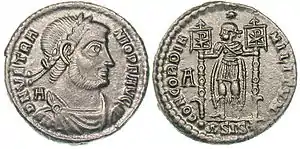Vetranio
Vetranio (died c. 356) was a Roman soldier, statesman and co-Emperor, a native of the province of Moesia (in modern Serbia).[1][2]
| Vetranio | |
|---|---|
| Augustus | |
.jpg.webp) Coin of Vetranio | |
| Roman emperor | |
| Reign | 1 March – 25 December 350 |
| Predecessor | Constans |
| Successor | Constantius II |
| Born | Moesia in modern Serbia |
| Died | c. 356 Bithynia |
Life and career
Early life
Vetranio was born in the almost uncivilized regions of the Roman province of Moesia, sometime in the late 3rd century, to low-born parents. His early professions are unknown, but it is evident that very early in his youth he joined the army.[3] Though unlettered, Vetranio rose rapidly through the ranks from obscurity, being ultimately elevated by Constans to the governor of Illyria. He held this command during a long period, and by the time of Constans' death (A.D. 350, January) was considered an officer of popularity and experience. After the murder of Constans by the usurper Magnentius, Constantina, Constans' sister and the daughter of Constantine the Great asked the aged Vetranio to assume the purple. She most likely thought Vetranio could protect her family and herself against the usurper, and merely hoped to secure his fidelity, though Edward Gibbon credits her notoriously unscrupulous ambition for the scheme, suggesting interested motives on her part.[4] In any case, Constantius II was then embroiled in a dangerous struggle with Shapur II, the king of the Sasanian Empire. Constantina may have doubted her brother's resolution.
Emperor

Vetranio accepted the purple, and coins were minted in his name, showing the title of Augustus (full emperor), rather than Caesar, and the coins indicated that he expected to rule for five years, and hoped for ten.[5] Constantius was not initially disinclined to accept the election of the Illyrian emperor, but the latter soon joined himself to the cause of Magnentius, and the two presented a united front against Constantius II in their embassy to his court at Heraclea in Thrace, whither he had arrived from the Persian war. They offered him the senior title in the Empire, and Magnentius proposed to wed his daughter to Constantius, himself to marry Constantia the emperor's sister. But they required that the emperor lay down his arms and ratify their claims to the western provinces. Constantius, supposedly inspired by his father Constantine in a nocturnal vision, indignantly declined the offer.[6]
Constantius, however, designed to conceal his enmity to Vetranio, and, while disdaining negotiation with Magnentius, speciously conceded his (Vetranio's) claims and title, wishing to reconcile him to his cause for the war against Magnentius. The vacillating Illyrian accepted the rapproachment, again uniting himself to the house of Constantine. Constantius met with Vetranio either at Naissus, or Sirmium, or at Serdica, to unite their strength for the war.[7]
Sardica
Constantius presently threw off the disguise. On 25 December 350, in a scene contrived by officers in Vetranio's army well-disposed towards Constantius, the two emperors mounted a tribunal to address the assembled legions; Constantius succeeded, by means of a strong speech, in which he invoked the glories of the house of Constantine I, to have the Illyrian legions acclaim him sole emperor. Vetranio threw himself on the ground and begged Constantius' clemency. The emperor gently raised the aged general by the hand, honoring him with the name of father, and gave him instant pardon.
Later life and death
Later he was dismissed in peace. Though dismissed from his command, he was allowed to live the remainder of his years as a private citizen on a state pension in Prusa ad Olympum, Bithynia. He lived a further six years, dying in simple happiness.[8] He is said to have recommended to Constantius as his friend, during his happy retirement in Brusa, that peace could only be obtained in a private station.[9]
See Philostorgius 3.22 for detail on his rise to power.
References
- Roman Empire, Vetranio
- Edward Gibbon, The Decline and Fall of the Roman Empire, (The Modern Library, 1932), ch. XVIII., p. 589, note 75
- Gibbon, Ibid, note
- Gibbon, p. 589
- Roma Numismatics: Roman Empire, Vetranio - Not so Loyal After All
- Gibbon, p. 590
- Gibbon, p. 591, note 78. Gibbon favors the latter.
- Gibbon, p. 592
- Gibbon, p. 592
External links
| Wikimedia Commons has media related to Vetranio. |
- M. DiMaio Jr., "Vetranio (350 A.D.)", in DIR (1996).
- Vetranio coinage
- Most complete internet database of known coin types of Vetranio
| Regnal titles | ||
|---|---|---|
| Preceded by Constans |
Roman emperor 350 |
Succeeded by Constantius II |